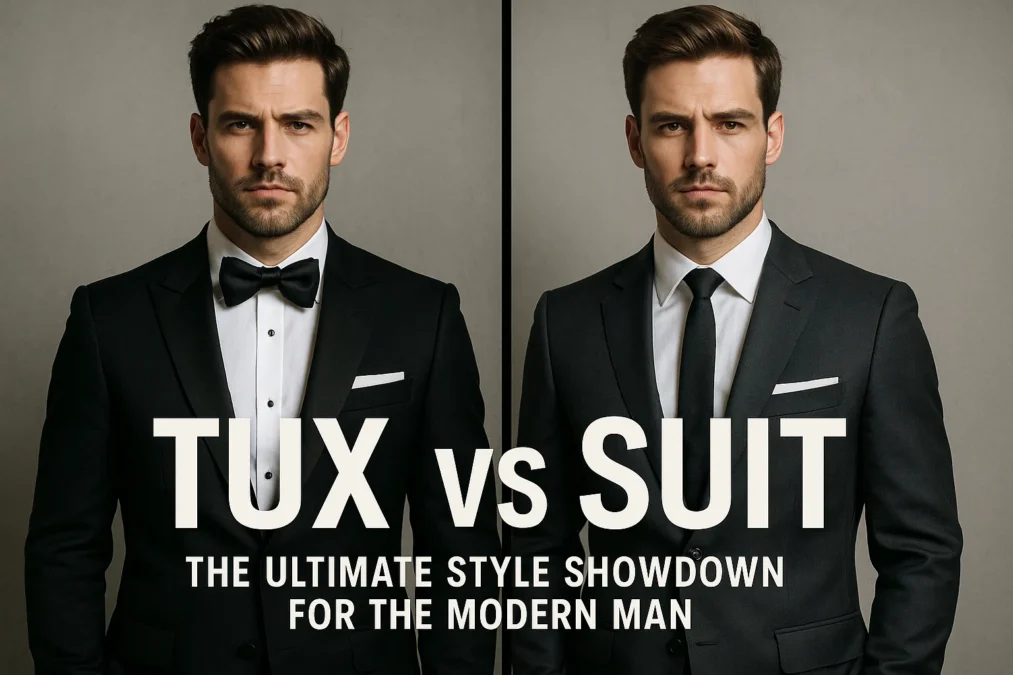You’ve got a big event on the calendar. Maybe it’s your wedding, a black-tie gala, or a milestone anniversary party. The invitation might even specify a dress code, but that often leads to more questions than answers. Your mind starts racing. What do I wear? Is this a tuxedo situation, or will my best suit do the trick? The age-old style dilemma of tux vs suit is one that every well-dressed man must solve. It’s more than just a choice of outfit; it’s a language of style, context, and respect for the occasion. Getting it right speaks volumes about your understanding of etiquette and your personal flair.
This isn’t just about picking the black one for fancy parties. The differences between a tuxedo and a suit are distinct, rooted in a century of sartorial history, and understanding them is the key to unlocking a new level of confidence in your formalwear. This comprehensive guide will demystify the tux vs suit debate once and for all. We’ll dive deep into the history, break down each component, and provide crystal-clear guidance on when to wear each. By the end, you’ll be equipped to make an informed decision that ensures you look impeccably appropriate and undeniably sharp, no matter the event.
The Heart of the Matter: Defining the Tuxedo and the Suit
Before we can compare them, we need to define them clearly. While they may look similar to the untrained eye, a tuxedo and a suit are designed for entirely different arenas of life. One is a specialist, a master of its specific domain. The other is a versatile all-rounder, the workhorse of a gentleman’s wardrobe. Knowing which is which is the first step to sartorial success.
A tuxedo, also known as a dinner suit or a black-tie outfit, is the undisputed king of evening formalwear. It’s not just a fancy black suit. It is a specific uniform with prescribed elements designed for events after 6 PM. Its entire purpose is to convey peak formality and elegance. The word “tuxedo” itself has a fun origin story, named after Tuxedo Park, a wealthy enclave in New York where it was reportedly first worn in the United States in the late 19th century. Its design is intentional, from the satin details to the lack of versatility, signaling that it is reserved for special, after-dark occasions.
A suit, on the other hand, is the fundamental building block of a man’s professional and social wardrobe. Its defining characteristic is its versatility. A suit is crafted from worsted wool or other fabrics where the jacket and trousers are made from the same material, and crucially, that material is entirely matte. You wear a suit to the office, to a daytime wedding, to a nice dinner, or to a court hearing. It is designed to be adaptable, to be dressed up with a tie and pocket square or dressed down with a simple knit polo. The suit is your sartorial Swiss Army knife, ready for a multitude of contexts where looking polished is required.
A Stitch in Time: The History and Evolution of Formalwear
To truly appreciate the tux vs suit difference, we must take a quick journey back in time. The suit, as we know it today, evolved from the elaborate and colorful court dress of the 17th and 18th centuries. Beau Brummell, a style icon in Regency England, is credited with pioneering the understated, well-tailored dark coat and trousers that became the precursor to the modern business suit. He championed fit, cleanliness, and simplicity over ostentatious decoration, a philosophy that still defines suiting.
The tuxedo has a more specific and rebellious origin story. In the Victorian era, the standard for formal evening wear was the tailcoat—a long, black coat with tails in the back and a white tie. It was the height of formality but also quite restrictive. As legend has it, in the 1880s, the son of a wealthy family in Tuxedo Park, New York, grew tired of the stuffy tailcoat and arrived at the club’s autumn ball in a tailless black jacket. Instead of being scandalized, his peers were impressed. This shorter, more comfortable jacket caught on and became known as the tuxedo. It was born from a desire for slightly less formality while still maintaining an air of exclusive elegance, carving out a new niche between the white-tie tailcoat and the standard business suit.
The Devil is in the Details: Breaking Down the Key Differences
This is where the tux vs suit debate gets practical. You can identify which is which by looking for a few very specific design elements. These details are non-negotiable and are the hallmarks that separate the formal specialist from the versatile everyday option.
The most immediate and obvious differentiator is satin. A tuxedo uses satin (or a similar shiny fabric, like grosgrain) as a decorative accent. You will find satin on the lapels of the jacket (this is called satin-faced lapels), a satin stripe along the outseam of the trousers, and satin on the buttons of the jacket. A suit has none of this. The jacket lapels are made of the same matte fabric as the rest of the garment, the trousers have no satin stripe, and the buttons are typically plastic or horn, matching the suit’s color. This use of contrasting texture is what gives a tuxedo its special occasion shimmer under evening lights.
Another critical difference lies in the accompaniments. A tuxedo is not just the jacket and trousers; it’s a complete system. It is traditionally worn with a formal shirt, which often has pleats or a bib on the front, and French cuffs designed for cufflinks. It is paired with a bow tie (never a long necktie in its purest form), and a cummerbund or a formal waistcoat to cover the waistband. Footwear is almost always highly polished patent leather or velvet slippers. A suit has no such required accompaniments. You wear it with a standard dress shirt, a long necktie or no tie at all, a leather belt, and standard dress shoes like oxfords or derbies. The tux vs suit wedding choice, therefore, impacts not just the main garment but your entire ensemble from head to toe.
The Formality Spectrum: When to Wear a Tux vs a Suit
Understanding the appropriate context for each is perhaps the most important part of this guide. Wearing a tuxedo to a business meeting would be as bizarre as wearing a suit to a white-tie wedding. It’s all about reading the room and the invitation.
A tuxedo is reserved for formal events that typically occur after 6 PM. The most common directive you’ll see is “Black Tie.” This means a tuxedo is not just suggested; it is required. This includes events like galas, opera openings, very formal weddings, and award ceremonies. “Black Tie Optional” gives you a choice; you can wear a tuxedo or a very dark, formal suit. “White Tie” is even more formal than Black Tie and requires a tailcoat, meaning your standard tuxedo won’t even cut it. The rule of thumb is simple: if the sun is down and the event is special, a tuxedo is your safest and most respectful bet.
A suit is your go-to for virtually every other professional and semi-formal occasion. This includes daytime weddings (which are generally less formal than evening weddings), job interviews, office wear, court appearances, religious services, and nice dinners that don’t have a specific black-tie code. The beauty of the suit is its range. A light grey or navy suit is perfect for a summer garden party, while a charcoal or dark navy suit can be pushed towards formality for an evening event if you don’t own a tuxedo. For a tux vs suit wedding, the time of day is your best clue: an evening reception almost always calls for a tuxedo for the wedding party, while a daytime ceremony is firmly in suit territory.
The Style and Color Palette: Expressing Personality Within the Rules
While tuxedos have strict traditional rules, modern fashion has introduced some flexibility. Similarly, suits offer a near-infinite canvas for personal expression. Knowing the rules allows you to break them with intention and style.
The classic tuxedo is black with peak or shawl lapels. This is the timeless, failsafe option. However, modern interpretations have expanded the palette. Midnight navy is a sophisticated and popular alternative that can look even blacker than black under certain lights. For the truly daring, white or ivory dinner jackets are acceptable for summer events or tropical destinations. Burgundy and deep green have also emerged as fashion-forward choices. While satin-faced lapels are standard, you might see a velvet tuxedo jacket for a ultra-luxurious look. The key is to ensure that even with a unique color, the other hallmarks of the tuxedo—the satin details, the bow tie, the formal shirt—are present to maintain its identity.
The world of suits is your oyster. From the standard navy and charcoal grey to patterns like pinstripes and windowpanes, and fabrics like flannel, linen, and tweed, the choices are endless. Lapel styles (notch, peak, shawl), button configurations (single-breasted, double-breasted), and pocket styles allow you to create a look that is uniquely yours. This versatility is why a man might own several suits but only one tuxedo. The suit reflects your daily personality, while the tuxedo is your uniform for unparalleled elegance.
The Investment and Versatility Factor
When considering your purchase, think about cost-per-wear. This practical metric often heavily influences the tux vs suit decision, especially for younger men or those new to formalwear.
A great suit is a workhorse. A well-chosen navy or grey suit can be worn to work, then dressed down for a weekend event by swapping the shirt and tie for a simple t-shirt or sweater. You can wear the jacket as a blazer with jeans and the trousers with a separate sports coat. This incredible versatility means a good suit gets worn dozens of times a year, making it a fantastic investment. The cost is justified by its frequent use.
A tuxedo, by its very nature, is a specialist tool. Unless you are a diplomat or regularly attend charity galas, it will likely spend most of its life in a garment bag. You might only wear it a handful of times a year. Therefore, the cost-per-wear is inherently higher. This is why many men initially opt to rent a tuxedo for their first few black-tie events. However, there is a strong argument for ownership once your lifestyle demands it. A rented tuxedo will never fit you as perfectly as one tailored to your body, and that perfect fit is the true essence of black-tie style. Owning one ensures you are always prepared for a formal invitation and always look your absolute best.
Tux vs Suit Wedding: A Guide for Grooms and Guests
The tux vs suit wedding question is perhaps the most common scenario where this dilemma arises. The answer depends heavily on your role and the specifics of the wedding.
For the Groom and Wedding Party: The formality and time of the wedding set the tone. A traditional evening wedding typically calls for the groom and his groomsmen to be in tuxedos. This creates a unified, elegant, and formal look that matches the significance of the occasion. For a daytime wedding, especially a less formal one in a garden or on a beach, suits are often more appropriate and comfortable. The couple should decide this early and communicate it clearly to the wedding party. The groom might also choose a different style or color of tuxedo lapel to distinguish himself from his groomsmen.
For the Wedding Guest: Your first step is always to read the wedding invitation. It will usually specify the dress code. “Black Tie” means a tuxedo is expected. “Formal” or “Black Tie Optional” often means you can wear a tuxedo or your darkest, most formal suit (navy or charcoal). “Semi-Formal” or “Cocktail Attire” is solidly in suit territory. If no dress code is specified, let the venue and time be your guide. An evening wedding at a luxury hotel or ballroom suggests a suit or even a tuxedo. A afternoon wedding at a rustic venue suggests a suit, perhaps even in a lighter color or fabric. When in doubt, it is always better to be slightly overdressed than underdressed.
Eau de Toilette vs Parfum: The Ultimate Guide to Understanding Fragrance Concentrations
Making the Choice: A Summary of Considerations
So, how do you finally decide? It boils down to asking yourself a few simple questions about the event and your personal needs.
First, consult the invitation. What does the dress code say? “Black Tie” ends the discussion: you need a tuxedo. Second, consider the time. Is it after 6 PM? This pushes the needle toward a tuxedo. Third, think about the venue. Is it a grand ballroom, an opera house, or a five-star hotel? Formality is expected. Is it a beach, a backyard, or a casual restaurant? A suit is the way to go. Finally, consider your role. Are you the guest of honor, a speaker, or a best man? This often necessitates stepping up your formality to show respect for the hosts and the event.
For your personal wardrobe, ask yourself about frequency. How often will you attend black-tie events? If it’s more than once a year, investing in a tuxedo you love is wise. If it’s a rare occurrence, renting is a perfectly fine option. For a suit, think about its future use. Will it be a cornerstone of your professional wardrobe? Then investing in quality, fit, and a versatile color is paramount.
Conclusion
The tux vs suit conversation is a fundamental pillar of men’s style, but it doesn’t have to be confusing. A tuxedo is the master of formal evening wear, defined by its satin accents and role as a complete formal system. A suit is the versatile champion of day-to-night professionalism and social events, defined by its matte finish and adaptability. The choice between them ultimately comes down to context: the time of day, the formality of the event, and the instructions on the invitation. By understanding their history, recognizing their key differences, and respecting their intended purposes, you can navigate any dress code with confidence. Whether you choose the specialized elegance of the tux or the reliable versatility of the suit, the goal is always the same: to look and feel your best, perfectly appropriate for the moment.
Frequently Asked Questions (FAQ)
What is the main visual difference between a tux and a suit?
The most immediate visual difference is the presence of satin. A tuxedo features satin-faced lapels on the jacket, a satin stripe down the side of the trousers, and satin buttons. A suit is made entirely of the same matte fabric throughout, with no shiny satin details anywhere. This use of contrasting texture is the quickest way to tell them apart.
Can I wear a regular necktie with a tuxedo?
Traditionally, no. The standard and correct accessory for a tuxedo is a bow tie. While modern fashion has seen some people experiment with long neckties, it is generally considered a breach of black-tie etiquette. The bow tie is an integral part of the tuxedo’s formal identity. For a true black-tie look, stick with a bow tie, preferably a self-tie one for the utmost elegance.
Is it okay to wear a black suit to a black-tie event instead of a tuxedo?
This depends on the dress code. If the invitation strictly says “Black Tie,” then a tuxedo is expected and a black suit, while better than something less formal, would still technically be underdressed. However, if the invitation says “Black Tie Optional” or “Formal,” a very dark, well-tailored black or navy suit can be acceptable. The key is to accessorize it formally—wear a white shirt, a black bow tie, and elegant shoes to get as close to the black-tie standard as possible.
For a daytime wedding, should I wear a tux or a suit?
For a daytime wedding, a suit is almost always the correct and preferred choice. Tuxedos are designed for evening wear (after 6 PM). A daytime wedding calls for the lighter, more versatile formality of a suit. Opt for colors like navy, light grey, or even tan depending on the season and venue. This is a key distinction in the tux vs suit wedding decision-making process.
How should a tuxedo fit compared to a suit?
The fit principles for both are very similar: shoulders should sit perfectly, the jacket should contour your body without pulling, and trousers should break cleanly on your shoes. However, some argue that a tuxedo can be tailored to be slightly more fashion-forward or sleek since it’s worn less frequently and for more stylistic events. Ultimately, whether it’s a tux or a suit, perfect fit is non-negotiable for looking your best.
Do I need to wear a cummerbund with a tuxedo?
A cummerbund or a formal waistcoat (vest) is a traditional part of the black-tie ensemble. Its original purpose was to cover the waistband of the trousers. Today, it is still considered a standard component of the “full” black-tie look. While you can wear a tuxedo without one, especially if your trousers sit high enough, adding a cummerbund completes the traditional, polished appearance and is highly recommended.
Comparison Table: Tuxedo vs. Suit
| Feature | Tuxedo | Suit |
|---|---|---|
| Formality | Formal, Eveningwear | Professional, Semi-Formal, Versatile |
| Lapels | Satin-faced (Peak or Shawl) | Self-faced (Notch, Peak; same matte fabric) |
| Trousers | Satin braid or stripe along outseam | Plain, no satin detail |
| Buttons | Satin-covered or matching lapel | Plastic, horn, or fabric; matching jacket |
| Primary Occasion | Black-Tie Events (Galas, Formal Weddings) | Business, Daytime Weddings, Daily Wear |
| Shirt | Formal shirt with pleats/bib, French cuffs | Standard dress shirt (various cuffs) |
| Neckwear | Bow Tie (standard) | Long Necktie (standard) |
| Waist Coverage | Cummerbund or Waistcoat | Belt or Side-Adjusters |
| Shoes | Patent Leather Oxfords or Opera Pumps | Oxfords, Derbies, Loafers (leather) |
| Versatility | Low (Specialized for evening) | High (Day-to-Night, Multiple uses) |
Expert Quotes
- Tom Ford: “Dressing well is a form of good manners.” This quote encapsulates why the tux vs suit choice matters—it’s about showing respect for your hosts and the occasion.
- Giorgio Armani: “The difference between style and fashion is quality.” This reminds us that whether you choose a tux or a suit, investing in quality construction and impeccable tailoring is what truly makes the outfit.
- Mason sartorial: “A suit is what you wear when you need to be dressed. A tuxedo is what you wear when you need to be undressed of your personality and dressed in the uniform of celebration.” This highlights the symbolic nature of the tuxedo as a uniform for special events.



